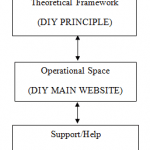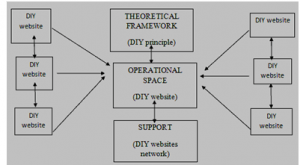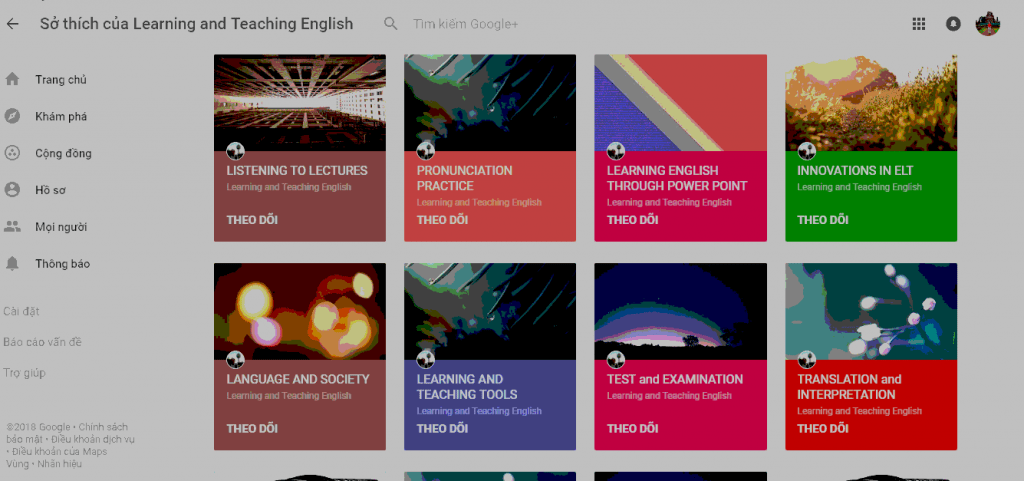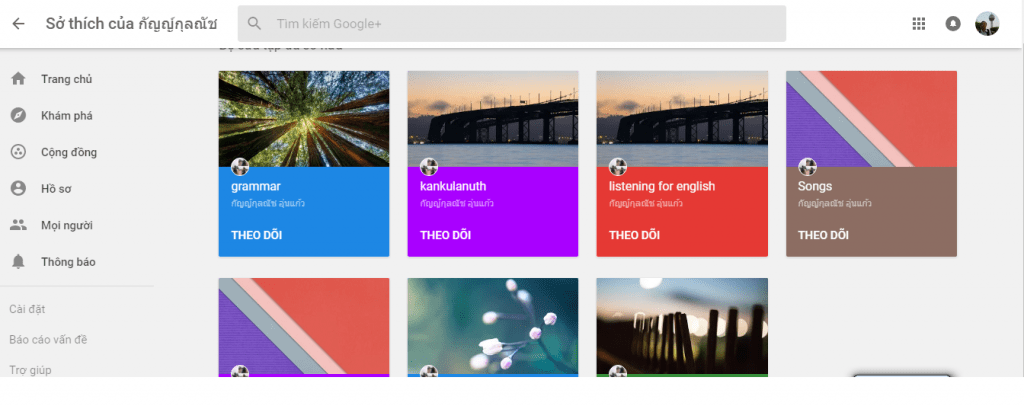By Nguyen Minh Trang
Constructing a do-it-yourself website as a rhizomatic personal learning environment to promote learner independence, interdependence and self-motivation to convert case.
The net generation
With the rapid development of the Internet, the current generation of students is called “net generation students” or “digital students”. Also, with the rapid spread of technology, a number of textbook publishers are predicting that traditional textbooks used today will become obsolete as more and more schools adopt digital textbooks for their digital curriculum and for use by students on their netbook computers (Shell, Gunter & Gunter, 2010, p. 501).
Scholars and researchers have predicted that traditional textbooks will fade into history as all areas of education create increasingly interactive and extensive Web- and video-enhanced digital textbooks. Furthermore, students can now access several sources more easily than the previous generation of students; therefore, traditional teaching methods mostly based on school textbooks do not really satisfy the needs of this generation of students. In fact, students, if they wish, are now able to access information from a multiplicity of highly reputable sources, not just from text books or lectures provided by their home institutions (Lian 2011, p. 6).
Self-directed learning models
Scholars and educators are developing “self-directed learning models”, “self-adjusting learning models”, or creating “personal learning environments” (PLEs). These digital environments can provide students with sufficient skills to survive and work in the fast changing world of the 21st century. It has been predicted that many new challenges in education are occurring globally, and only those who catch up with state-of-art technology will survive and develop (Pineda & Lian, 2013). Thus, constructing a learning structure or a learning model for students to be able to use online open sources inside and outside of classroom has been the concern of many educational experts, hoping to maximize the use of free sources that are still not scientifically collected in systems and which can be accessed easily from the Internet.
A rhizomatic personal learning environment
Concerning the application of technology to make use of Internet resources efficiently, Tochon, Karaman and Ökten (2014) say,
“If we can organize online open resources by themes that can be freely selected and thus support agency, there is an opportunity that such organizational environments will help scaffold deeper learning on the basis of shared intrinsic motivation.” (p. 73).
Lian (2011) also voices his concerns about this matter when he states, “Technology-based environment designed to enable language learners to develop their meaning-making mechanisms by providing opportunities to confront, contrast and contest their understanding with examples of the foreign language at work” (p. 5), because as we all know, learning is really a private matter, and online sources form the Internet if tactfully collected and data-based will provide learners great opportunities to tailor their self-adjusting or self-directed learning that meets their own interests and needs.
Therefore, in order to establish such a useful network that helps language learners study interdependently, work collaboratively with friends and receive help or support to solve their personal learning problems, we think of a rhizomatic PLE structure recommended by Lian (2011).
What a rhizomatic PLE structure looks like?
According to Lian (2011), a rhizomatic PLE structure “conceptually is like the root of a ginger plant whose parts have no obvious and clear connecting points. Instead, every point is potentially connected to every other point.” (p. 11). The structure consists of three main components or layers: Theoretical Framework, Operational Space and Support or Help section as illustrated by Figure 1 below.

Figure 1: A basic structure of DIY website project
This structure has the following strengths:
- This structure contains components where each and every component is connected to each and every other component of the structure.
- This structure is viewed as a self-regulating/self-adjusting structure that responses to the learner’s manageable needs.
- This structure is best applicable to learners who have complete freedom to pursue their independent, interdependence learning, and self-motivation. Those who are still dependent on school obligatory programs also gain benefits while using this rhizomatic structure to seek supplementary materials for their required courses.
- This structure can be easily constructed without much knowledge of technology and when it is put into operation, it will make full use of free and open sources from the Internet.
- It helps users save time and money (as it is completely free) searching for resources they need.
Do it yourself
The term “do-it-yourself” has been associated with consumers since 1912, primarily in the domain of home improvement and maintenance activities. The phrase “do it yourself” was in common usage (in standard English) by the 1950s, in reference to the emergence of a trend of people doing home improvement and various other small craft and construction projects as both a creative-recreational and cost-saving activity. In time, the term DIY has developed a broader meaning which covers widely different skill sets. In education, DIY is associated with project-based teaching and learning when students create things they really love or need.
DIY projects require creativity, making good use of existing materials to save time and project cost. The DIY project implementers take responsibility and share their resources with other people, and give people help hand when they face problems.
The principle that we have in mind when designing websites for personal use is the Do-It-Yourself (DIY) principle. According to this DIY principle, DIY provides people with opportunities to do things that they need but still lack. With DIY, people do things by themselves to satisfy their curiosity or intrinsic motivation. In academic research, DIY is described as behaviors where “individuals engage raw and semi-raw materials and component parts to produce, transform, or reconstruct material possessions.” (http://en.wikipedia.org/wiki/Do_it_yourself).
Designing and developing a do-it-yourself website
Learners of English can design DIY websites with sources collected or created by students themselves. Every student will have the freedom to use free website templates to design their DIY websites, upload materials needed for their own study or their group study, build links and share free open resources with other users. When more students join the project, the basic DIY website structure will be greatly expanded to serve the different needs of different groups of students. The DIY website-designing structure then will look like the structure below

Figure 2: An expanded DIY web-design structure
A social structure
By using this expanded DIY structure, learners now have more resources to share with other people in the fields of their own interests. This expanded structure will assist learners to have more links to other DIY websites, and consequently a social structure will be built among students and teachers themselves. If this expanded structure is carried out well, each DIY website will serve its part as a small online library that is closely connected to a bigger “online libraries” network. If DIY website owners select good sources for their DIY websites, build good links with other DIY websites, they will attract more users and will establish more page links. Moreover, if website owners build links to other good resources, they can make good use of other DIY website resources, and this will help reduce the load of database storage.
Another benefit is that while designing DIY websites, students can learn many practical skills. As students design websites, search for good sources, try out their pages, and improve their websites, students will have good opportunities to develop research skills, critical thinking skills, and this can “transform people into researchers.” (Lian 2011, p. 7)
Designing DIY websites and sharing DIY website resources
Designing DIY websites and sharing DIY website resources aims to:
- Raise the awareness of the DIY spirit amongst students. This spirit will help learners gain more power to develop their independence and interdependent learning.
- Engage students in collaborative work through project-based activities.
- Create facilities which make it possible for different perspectives to collide and for the participants to explore forms of legitimation in terms of which they construct and enact reality. (Lian, A.B., 2003)
- Strengthen learning communities within and beyond educational institutes.
Developing learner independence, interdependence and intrinsic motivation
When students learn to design DIY websites, they are encouraged to search for free website providers that best serve the students’ needs. However, as students may be confronted with an enormous mass of information from the Internet, they might be confused and not able to find proper website providers from which they can obtain free websites. Teachers then can provide students with free website addresses such as WordPress.com, Webs.com, Diigo.com or Moodle.org (to name just a few) so that students can select good free website templates to start the project.
Then students themselves are required to select pertinent elements that matter to their study. They are encouraged to search the Internet and find out websites they think are the best websites, or the websites that have a large number of users/registers, analyzing these website components to find out the website strengths and weaknesses so that they can imitate using these components in their designed DIY websites. This process requires students to work independently first, and then interdependently with other groups to receive feedbacks from friends before designing their own DIY websites.
In doing so, the students of this DIY project will gain the following characteristics:
(a) “internal evaluation” by the student, i.e. evaluation by learners of their own language usage and requirements (Holec, 1979);
(b) “learning how to learn”. It is important that students can evaluate activities they perform inside and outside the class, and thus become aware of their own learning processes as “only then will they become conscious of what does or does not suit their learning style and so structure their learning experience accordingly.”(Crawford, 1985 as cited in Lian, 1993, p. 4)
Students then will be in a position:
(a) to make the best use of their own personal resources as well as the resources provided by their own learning institution, and
(b) to proceed with their learning in an independent mode.
Operational Space
The tool of this project is a DIY website designed by each student as a database to store good materials for use and introduce the website to language learners, asking them for feedback, building links with other DIY websites to form a DIY website network. Initially starting from just one DIY website designed by the instructor himself or herself for personal use and for student use, students can join this project, designing their DIY websites for their own learning that helps form a network of DIY websites which contain many useful sources from the open and free Internet for the whole community to use.
The network by time will be greatly expanded as other groups of students from other educational settings will participate in the network. Hopefully, other instructors who are interested in enriching their teaching materials will also join this network and stay there as helpers, specialists or advisors who can provide students with good ideas to help solve problems which students face.
Support/Help Section
Notice that from the first day of this project, there is only one teacher who is charge of the class, voluntarily designing this DIY website and sharing the website resources with his or her learners and with other teachers. The instructor then plays a role of a supporter or helper to the website users. When the project is introduced to students, the user cycle then will be greatly expanded. Each user of this network will help other users when they have problems that need to be solved.
Students who join this project surely want to construct better and more useful DIY websites for their own use and for that of their friends; therefore, students will have to study from other website designers. They also have to think of interesting components to put in their DIY websites. As a result, students will have good opportunities to share ideas, work collaboratively with other students to improve their websites, asking other students, users or teachers for help to solve the problems they face. Help then comes from other website resources or directly from the website owners. Help also comes from any person who has joined the network.
As a result, linguistic communities of practice will be formed and students will seek help from these sources. The more widely the links students build, the more quickly they will receive people’s help. DIY websites will then be the Learner Support Resource (LSR) and the website designers will play a role of helpers to website users. A good social network of helping each other to solve personal learning problems or matters will be formed and expanded day by day. Imagine how rich this DIY network’s resources are when counted in years!
However, in order to have their problems solved quickly, students’ needs should be manageable and clearly be expressed.
Website forums and blogs are good places where students can ask “all-knowing” teachers and advisors for help.
Peer assistance is another support channel students can seek. Students are intelligent and if there are good relationships established among students, surely they can seek help from friends faster and more conveniently than from teachers and experts who seem rather busy with their work. In this case, the DIY spirit develops among community members and interdependence will be well established. As students search for resources from the Internet to have materials for their website components, student skills in searching the Internet to obtain information and good sources will be improved, and these established skills will in turn help them find solutions to their own problems more easily than those who do not perform these practices.
One thing that students should know is that in order to save time searching for learning materials, DIY website owners should create themes or categories with their pages like Yahoo and other popular websites have done. Groups of volunteers from this DIY network will categorize these DIY websites into themes or topics, and build quick links to other DIY websites for learners’ future convenient search. This can save time for DIY website users when they look for resources they need.
How can Students Share and Connect to Other Students’ Websites to Form their Rhizomatic PLEs?
To make it simple, I used Collections from Google+ to form my RPLE. With Google+, I can create at least 40 collections grouped by themes (see (https://plus.google.com/b/109508095537792600363/+LearningandTeachingEnglish).

Students who are interested in any theme of my RPLE can click on “FOLLOW” (Vietnamese word THEO DÕI) to access my RPLE, using resources I have uploaded there and sharing them with their friends. They should copy URL and paste it on their websites. In turn, I can “follow” my RPLE users, copy their URLs to paste them on my websites.
To know who followed me, I can check it rather easily by clicking on “followers”.

Below is a website of my Thai student from Suranaree University of Technology, Thailand. She has seven collections of her RPLE ready for use and to share with friends.

A Thai student designed a RPLE for personal use and ready to be shared with friends.
From my collections and students’ collections, I can click on “Followers” to have more links to other websites, and easily import useful resources from their websites to enrich my own RPLE. Perhaps I can create my own resources, upload them and share them with my students and my fellow-teachers. One interesting thing that is worth noticing is that if students use Collections from Google+ to create their websites, information and resources uploaded on their RPLEs are unlimited. If they use other free website templates, space to store resources is rather limited, and usually the website servers recommend that students upgrade websites which costs money.
Conclusion
Designing a website is not a new task, especially in the commercial world, but the ideas of how to connect these websites designed by students themselves in educational settings to enhance textbooks or course books are not often emphasized by teachers. As said, textbooks or course books will disappear soon, or information from textbooks or course books may become obsolete by the time they are published.
Thus the idea of designing DIY websites and sharing authentic materials which students have collected and created sounds interesting and useful.
If students still have to use obligatory textbooks or course books, DIY websites still work well with students as supplementary materials to enhance their knowledge. With the idea of connecting DIY websites into a DIY language network, we can save resources that exist. By encouraging learners to construct their own DIY websites, this project can raise the DIY spirits among students.
The project can help students to develop their skills in searching for good materials for their own use. Students will develop good critical thinking skills when they compare, contrast and collide with problems they face when participating this self-directed or self-adjusting project. Without worrying about grades or tests, learners can join this DIY project any time they like, and students will feel at ease to perform the website designing tasks to satisfy their self-motivation or intrinsic motivation. This task is viewed as fun and useful, especially when students recognize they can create things that are useful for themselves and for other people. However, in order to make this DIY project successful, students and teachers will have to design their DIY websites with great care and with much patience.
Do you think you can construct your DIY website for learning creatively?
References
- Dudeney, G & Hockly, N., (2007). How to teach English with technology. PEARSON Longman, UK.
- Lian, A. B. (2003). Beyond illusions and facts: Toward a methodology of dialogue and dialogue-enhancing environments. Paper presented at The International Conference on Computers and Philosophy, ANU,
- Australia and Rice University, Texas, USA.
- Lian, A-P., Hoven, D. L. & Hudson, T. J. (1993) Audio-Video Computer Enhanced Language Learning and the
- Development of Listening Comprehension Skills, Australian Second Language Learning Project, pp. 25-41.
- Lian, A-P (2011). Reflection on language-learning in the 21st century: The rhizome at work. RJAS Journal, No. 1 Jan.-Jun., p. 5-16.
- Pineda, M. V. & Lian, A-P. (2013). In search of an adaptive learning model for the ASEAN community in the 21st century.
- Shell, G.B., Gunter, G.A., & Gunter, R. E. (2010). Teachers discovering computers. Integrating Technology and
- Digital Media in the Classroom. USA: COURSE TECHNOLOGY. CENGAGE Learning.
- Tochon, F.V., Karaman, A. C., & Ökten, C. E. (2014). Online instructional personal environment for deep language learning. International Online Journal of Education and Teaching, Vol.1, No 2.
- Nguyen Minh Trang is a lecturer of English as a foreign language at Binh Duong University, Vietnam. He has taught English at college and university level in South Vietnam for over 32 years. He gained his B.A. in TESOL from Ho Chi Minh City University of Education in 1985, and a Master’s degree in TESOL from Victoria
- University, Australia in 2010. During his PhD studies in Thailand, he had an opportunity to teach English and
- Vietnamese to Thai students at Suranaree University of Technology. His research interests are CBI issues, ELT methods, academic listening, translation and interpretation, and sociolinguistics.




